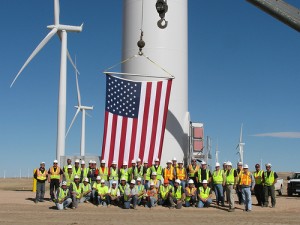A National Clean Energy Standard Is Good Policy --- And Good Politics
 Do anti-clean energy senators have any idea what Americans want? If this morning’s hearing on the Clean Energy Standard Act of 2012 is any guide, they don’t. The truth is that Americans support a clean energy target for this country. Senators should listen to the American public and pass this bill.
Do anti-clean energy senators have any idea what Americans want? If this morning’s hearing on the Clean Energy Standard Act of 2012 is any guide, they don’t. The truth is that Americans support a clean energy target for this country. Senators should listen to the American public and pass this bill.Let’s start at the beginning. In her opening remarks, Senator Lisa Murkowski (R-AK) asked, “To me, the biggest question … is whether American’s really want a CES?”
If that’s the biggest question, then it’s time for the Senate to pass the CES Act, because the American people want more clean energy.
According to the Pew Research Center, a majority of Americans think that developing clean energy sources should be a bigger priority than expanding oil and coal production. This is exactly what a CES would do. The Energy Information Administration testified today that the Clean Energy Standard Act would lead to increased electricity generation from all low-carbon sources of power including renewables, nuclear, and natural gas. While the exact mix of those resources is impossible to predict, wind and solar power increase dramatically in every scenario the EIA has analyzed.
That wasn’t the end of Murkowski’s misunderstanding of what the American people want. She went on to say to the witnesses, “I think this is where the consuming public is coming from: If this is going to save me money, let’s talk about it; if it’s not, let’s not talk about it.”
In fact, that’s not where the consuming public is coming from. Researchers from Harvard and Yale have found that Americans would be willing to pay an extra $162 per year to get 80 percent of their electricity from clean sources. Conveniently, that’s exactly what the CES would do, so we know that Senator Murkowski’s presumption about what the public wants is wrong. It’s also important to remember that while the EIA predicts small electricity rate increases from the CES, CAP’s analysis of state renewable energy standards shows that there’s no evidence that this policies increase rates.
Unfortunately, Senator Murkowski’s thinking is stopping the Senate from passing this common sense legislation that would drive clean our air, help prevent catastrophic climate change, and drive investment that can reinvigorate our economy.
Some senators are siding with the American people, though. Senator Jeff Bingaman (D-NM), who originally introduced this proposal and is leading the fight for a CES, understands why this bill is critical. His opening statement is a welcome contrast to Murkowski’s:
The purpose of the Clean Energy Standard is to establish a national standard for electricity to make sure that we leverage the clean resources we have today and provide a continuing incentive to develop the cheaper, cleaner energy technologies of the future. By design, it would drive continued diversity in our sources of energy, and it would also allow every region to deploy clean energy using resources appropriate to that region. The Clean Energy Standard does this in a way that is intended to support home-grown innovation and manufacturing, and keep America competitive in the global clean energy economy.
Using cheaper, clean energy technologies to support innovation and manufacturing is something that everyone should get behind. That’s why the Center for American Progress has supported this bill from the start. As Kate Gordon, CAP’s Vice President for Energy Policy, said when the bill was first introduced:
Sen. Jeff Bingaman’s (D-NM) proposal would be a tremendous contribution to the United States’ clean energy economy. By prioritizing low-carbon energy sources, a clean energy standard would drive investments in renewable energy and other low-carbon energy infrastructure that will put Americans back to work while also improving our air quality and reducing the likelihood of catastrophic climate change. This bill will also create stable demand that’s critical for growing our domestic clean energy manufacturing base, and will help spur new innovations in the low-carbon energy technologies of the future.
There are legitimate policy questions about the design of this bill. It would be good to find a way to include more support for energy efficiency, although there are technical challenges with treating efficiency as a resource just like power generation. And, Duke Energy explained today why they’re afraid that the CES could lead to over-reliance on natural gas. These issues can and should be dealt with while still supporting the bill.
You can return to the main Market News page, or press the Back button on your browser.

